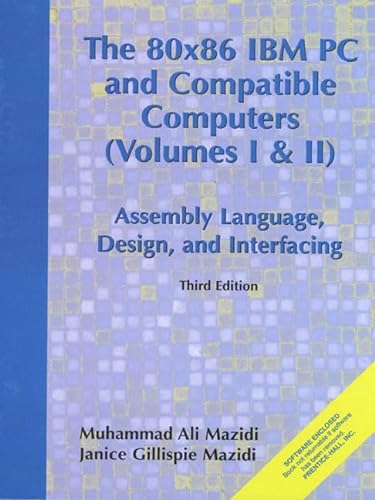80X86 IBM PC and Compatible Computers: Assembly Language, Design and Interfacing Vol. I and II - Hardcover

Inhaltsangabe
For microprocessor courses teaching the 80x86 family.
Praised by experts for its clarity and topical breadth, this visually appealing, one-stop source on PCs uses an easy-to-understand, step-by-step approach to teaching the fundamentals of 80x86 assembly language programming and PC architecture. Offering students a fun, hands-on learning experience, it uses the Debug utility to show what action the instruction performs, then provides a sample program to show its application. Reinforcing concepts with numerous examples and review questions, its oversized pages delve into dozens of related subjects, including DOS memory map, BIOS, microprocessor architecture, supporting chips, buses, interfacing techniques, system programming, memory hierarchy, DOS memory management, tables of instruction timings, hard disk characteristics, and more.
Die Inhaltsangabe kann sich auf eine andere Ausgabe dieses Titels beziehen.
Reseña del editor
For microprocessor courses teaching the 80x86 family. Praised by experts for its clarity and topical breadth, this visually appealing, one-stop source on PCs uses an easy-to-understand, step-by-step approach to teaching the fundamentals of 80x86 assembly language programming and PC architecture. Offering students a fun, hands-on learning experience, it uses the Debug utility to show what action the instruction performs, then provides a sample program to show its application. Reinforcing concepts with numerous examples and review questions, its oversized pages delve into dozens of related subjects, including DOS memory map, BIOS, microprocessor architecture, supporting chips, buses, interfacing techniques, system programming, memory hierarchy, DOS memory management, tables of instruction timings, hard disk characteristics, and more.
„Über diesen Titel“ kann sich auf eine andere Ausgabe dieses Titels beziehen.
Suchergebnisse für 80X86 IBM PC and Compatible Computers: Assembly Language,...
80X86 IBM PC and Compatible Computers: Assembly Language, Design and Interfacing Vol. I and II (3rd Edition)
Anbieter: ThriftBooks-Atlanta, AUSTELL, GA, USA
Hardcover. Zustand: Very Good. No Jacket. May have limited writing in cover pages. Pages are unmarked. ~ ThriftBooks: Read More, Spend Less. Artikel-Nr. G0130165689I4N00
The 80x86 IBM PC and Compatible Computers (Volumes I & II); Assembly Language, Design, and Interfacing
Anbieter: Ground Zero Books, Ltd., Silver Spring, MD, USA
Hardcover. Zustand: Good. xxxviii, 984 pages. Illustrations. Appendices. References. Index. Software disk. Book has wear, soiling and corners worn through. Front board has weakness. This is a large, heavy book that if sent outside of the U, S. would require additional shipping charges. Praised by experts for its clarity and topical breadth, this visually appealing, one-stop source on PCs uses an easy-to-understand, step-by-step approach to teaching the fundamentals of 80x86 assembly language programming and PC architecture. It uses the Debug utility to show what action the instruction performs, then provides a sample program to show its application. Covers all of the x86 microprocessors, from the 8088 to the Pentium Pro. Combines assembly and C programming early on. Introduces the x86 instructions with examples of how they are used, and covers 8-bit, 16-bit, and 32-bit programming of x86 microprocessors. For anyone interested in computers and the 80x86 computer family. Muhammad Ali Mazidi (May 10, 1954 August 30, 2022) was an Iranian-born electrical engineer, author, and lecturer based in Texas. He was the co-author of The 80x86 IBM PC and Compatible Computers, a widely used textbook published by Prentice Hall, as well as the widely cited author of several editions of The 8051 Microcontroller and Embedded Systems. Mazidi went to Tabriz University and held master's degrees from both Southern Methodist University and the University of Texas at Dallas. He founded MicroDigitalEd and taught microprocessor-based system design. Janice Gillispie Mazidi has a Master of Science degree in Computer Science from the University of North Texas. The 80x86 IBM PC and compatible computers refer to the line of personal computers that use Intel's 80x86 family of microprocessors and have achieved compatibility with the original IBM PC, leading to the creation of a widespread industry standard. This compatibility was established through IBM's open architecture and the use of standard components, with Microsoft's MS-DOS operating system also playing a key role in paving the way for third-party manufacturers to create compatible clones. These computers form the basis of much of modern computing and are often used as a subject for learning about computer architecture and low-level programming, particularly assembly language. Key aspects: Microprocessor: The use of x86-based central processing units, originally from Intel and later from other vendors like AMD, is a defining feature. The IBM PC's open architecture, which used off-the-shelf components, enabled other companies to design and manufacture compatible machines. The Basic Input/Output System (BIOS) was the primary proprietary piece of hardware for the original IBM PC, managing essential functions like the boot sequence and runtime services. Microsoft's MS-DOS was licensed to many manufacturers, allowing software designed for the IBM PC to run on compatible clones. Some compatible machines used hardware abstraction layers to allow programs to function on different hardware configurations, often through the use of MS-DOS application programming interfaces. The 80x86 family is a popular subject for learning about computer architecture and assembly language programming due to its foundational role in personal computing. Third Edition [stated]. First printing [stated]. Artikel-Nr. 90619
Gebraucht kaufen
Anzahl: 1 verfügbar
